Rev. Mar. Cost. ISSN 1659-455X. Vol. 3: 99-109, Diciembre 2011.
DOI: https://doi.org/10.15359/revmar.3.8
GROWTH AND MORTALITY OF LAGODON RHOMBOIDES (Pisces: SPARIDAE) IN A
tropical COASTAL LAGOON IN
NORTHWESTERN YUCATAN, MEXICO
CRECIMIENTO Y MORTALIDAD DE LAGODON RHOMBOIDES (PISCES: SPARIDAE) EN UNA
LAGUNA TROPICAL COSTERA EN EL NOROESTE
DE YUCATÁN, MÉXICO
Recibido 29-III-2011
Aceptado 17-VIII-2011
José Luis Bonilla-Gómez1*, Jorge A. López-Rocha2, Maribel Badillo Alemán2, Juani Tzeek Tuz2 and Xavier Chiappa-Carrara2
1 Posgrado en Ciencias del Mar y Limnología, Universidad Nacional Autónoma de México. Circuito exterior S/N, Ciudad Universitaria, México D. F., México. C. P. 04510. *jose.bonilla@comunidad.unam.mx
2 Unidad Multidisciplinaria de Docencia e Investigación de Sisal (UMDI-Sisal, UNAM). Puerto de Abrigo s/n, Sisal, Hunucmá, Yucatán, México. C.P. 97356. jorgelopezrocha@ciencias.unam.mx, maribaam@yahoo.com, la_biologa@hotmail.com, xcc@ciencias.unam.mx
ABSTRACT
Growth and mortality were estimated for the Lagodon rhomboides pinfish inhabiting La Carbonera, a tropical coastal lagoon on the northwestern coast of the Yucatan Peninsula, Mexico. A total of 448 juvenile and adult individuals were collected monthly between April 2009 and May 2010. The length-weight relationship was calculated and the monthly variation in the condition factor was analyzed. Growth was estimated through the von Bertalanffy growth equation using a length frequency analysis. In addition, mortality was estimated and analyzed. Results showed that fish caught were between 2.1 and 20.0 cm long with an average length of 9.42 cm. The length-weight relationship showed isometric growth. The von Bertalanffy growth model parameters were: L∞ = 21.0 cm, W∞ = 163.46 g, k = 1.1 year-1 and t0 = - 0.158 years. Instantaneous mortality rates were 2.11 and 2.61 year-1 as estimated by the method used. According to the results, growth estimates of L. rhomboides along the northwestern coast of Yucatan are higher than those found in the population studied in Florida, suggesting a strong influence of environmental conditions in the growth pattern of this species. This study provides the first growth and mortality estimates for L. rhomboides in the Yucatan Peninsula, which is relevant for the proper implementation of conservation measures for this species.
Keywords: Lagodon rhomboides, von Bertalanffy, ELEFAN I, length-weight relationship, natural mortality.
RESUMEN
Se realizaron estimaciones de crecimiento y mortalidad del pez Lagodon rhomboides que habita en la laguna costera tropical La Carbonera, al noroeste de la península de Yucatán, México. Se obtuvieron 448 individuos en estadios juveniles y adultos recolectados mensualmente de abril del 2009 a mayo del 2010. Se obtuvo la relación peso-longitud y se analizó la variación mensual del factor de condición. El crecimiento se estimó a través de la ecuación de crecimiento de von Bertalanffy mediante un análisis de frecuencias de longitudes. Adicionalmente se obtuvieron estimaciones de mortalidad. Los resultados mostraron que los peces capturados presentaron tallas entre 2.1 y 20.0 cm de longitud total con un promedio de 9.42 cm. La relación peso-longitud mostró un crecimiento de tipo isométrico. Los parámetros del modelo de crecimiento de von Bertalanffy fueron: L∞ = 21.0 cm, P∞ = 163.46 g, k = 1.1 año-1 y t0 = - 0.158 años. Las tasas instantáneas de mortalidad presentaron valores de 2.11 y 2.61 año-1 según el método de estimación utilizado. De acuerdo con los resultados, las estimaciones de crecimiento de L. rhomboides de la costa noroeste de Yucatán son más altas que las encontradas para la población de Florida, lo que sugiere una alta influencia de las condiciones ambientales en el patrón de crecimiento de esta especie. En este estudio se proveen las primeras estimaciones de crecimiento y mortalidad para L. rhomboides en la península de Yucatán, lo que es relevante para la adecuada implementación de medidas de conservación de la especie.
Palabras claves: Lagodon rhomboides, von Bertalanffy, ELEFAN I, relación talla-peso, mortalidad natural.
INTRODUCTION
Growth increases size and weight of an organism, as well as its structure, which leads to an increase in total size. Ecological studies on fish, particularly those related to growth, are useful in determining the functional role of this group in an ecosystem (Martínez-Porchas et al. 2009). Age, length and weight are necessary variables in understanding the dynamics of a population and, just as environmental factors, they are key in understanding the importance of a population in a particular habitat (Shervette et al. 2007). Growth of juvenile fish is considered one of the most important factors contributing to the future progression of adult populations within a habitat (Beck et al. 2001).
Studies have analyzed growth and natural mortality of Lagodon rhomboides on the Florida peninsula in the northeastern Gulf of Mexico (Nelson, 1998; 2002). L. rhomboides, a member of the Sparidae family, is known colloquially as pinfish, pin perch and bream (Muncy, 1984; Carpenter, 2002) and locally as “sargo” and “xlavita” (Canto-Maza and Vega-Cendejas, 2008). It is an estuarine dependent species with ecological, recreational and commercial importance (Robins et al. 1986). Pinfish inhabit coastal waters from Massachusetts to Florida and Bermuda, including the Gulf of Mexico, the Yucatan Peninsula and the northern part of Cuba (Hoese and Moore, 1977). It is commonly found in bays, estuaries and coastal lagoons, especially in meadows of Thalassia testudinum, and mangrove roots (Adams et al. 2004). Pinfish is a dominant species in many Yucatan coastal lagoons (Vega-Cendejas, 2004) and, in spite of its numerical abundance, frequency and wide distribution, the species is not fished in northwestern Yucatan peninsula.
The purpose of this study is to estimate growth and mortality of L. rhomboides in La Carbonera coastal lagoon in northwestern Yucatan peninsula. This lagoon has two distinct features: its shallowness, which is about 30 cm average, and the confluence of waters from oceanic and underground sources.
The results presented in this paper constitute the first assessment of growth parameters of this species off the Yucatan coast and may serve as a basis for the development and implementation of a regional conservation and management plan.
MATERIALS AND METHODS
Study area: Sampling was conducted monthly between April 2009 and May 2010 in La Carbonera coastal lagoon, in the northwestern Yucatan peninsula, Mexico (21°13’- 21° 14’ N; 89° 52’ - 89° 54’ W) (Fig. 1). This lagoon is connected to the sea by a canal, or mouth, that was formed by Hurricane Gilbert which hit the Yucatan coast in 1988. The lagoon’s fresh water comes from groundwater discharges and rainfall. Due to differences in precipitation and temperature, this region has three characteristic climatic seasons: dry (March-June), rainy (July-October) and north winds (November-February) (Arceo-Carranza and Vega-Cendejas, 2009). Temperature (ºC) and salinity were determined at each sampling station with a Yellow Springs Instrument (YSI), model 556 MPS.
Juvenile and adult organisms were caught with a 40 m long seine net, with 1 m deep and 1.27 cm (0.5 inch) stretch mesh, in 9 sampling stations along the lagoon during each field trip (see Fig.1).
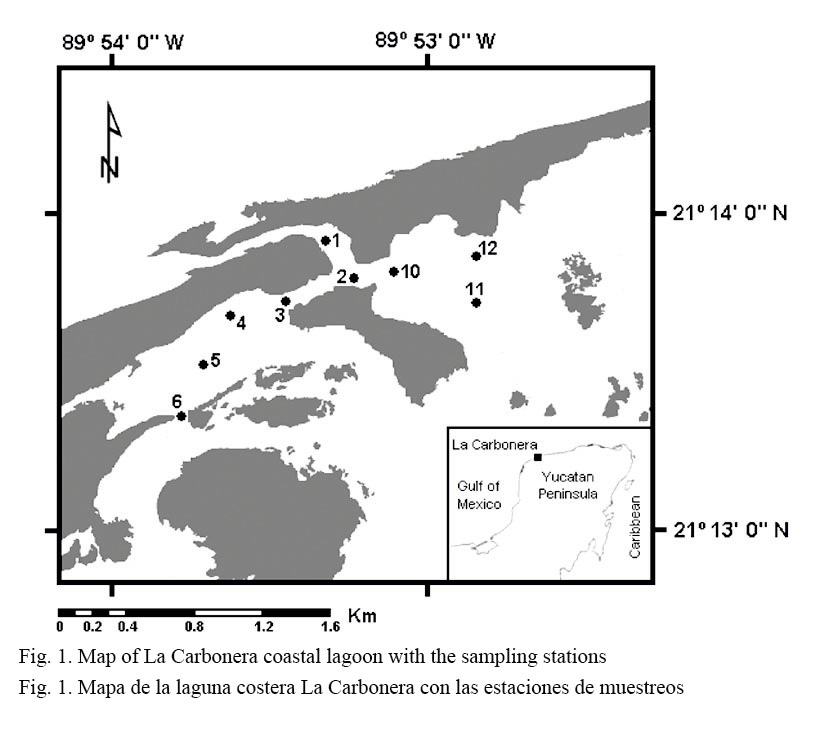
Relationship between total length and weight: morphometric variables were determined for each specimen: total length (Lt ± 0.1 cm), measured from the tip of the upper jaw to the tip of the tail fin, and total weight (W ± 1.0 g). A relationship between weight and total length was used to estimate growth through the power equation by Sparre and Venema (1995):
 (1).
(1).
where W represents the weight (g), Lt is the total length (cm), parameter a is a constant and b is the slope of the model. To determine parameters a and b in the equation (1), a regression analysis and a least square analysis were used. The estimated b parameter was evaluated with a t-student test to assess isometry in the length-weight relationship (Pauly, 1983).
Parameters of the von Bertalanffy growth function (VBGF) were determined through the ELEFAN-I software included in the package FAO-ICLARM Stock Assessment Tools (FiSAT II) (Gayanilo et al. 1997), using length frequency distribution with class intervals of 2 cm of total length. The VBGF is expressed as follows:

where Lt is the length at age t, L∞ is asymptotic length, K is the growth rate (year-1) and t0 is the hypothetical age at which fish length is zero.
In order to assess the variability of k taking into account the uncertainty in the estimation of asymptotic length, estimated values of maximum length and its 95% confidence interval from the routine Maximum Length Estimate included in FiSAT II (Gayanilo et al. 1997) were used to obtain a range of possible values for k.
The hypothetic age at which the fish length is zero (t0) was calculated separately using Pauly´s empirical formula (1979), defined as follows:

Once parameters of growth in length were obtained, equation (1) was used to obtain the VBGF by weight, expressed as follows:

where Wt is the weight at age t, W∞ is the asymptotic weight and b is the isometry coefficient.
To compare different growth estimates for this species, the growth index f’ proposed by Munro and Pauly (1983) was used:

The maximum longevity of individuals (tmax) was calculated through Pauly´s equation (1983) defined as follows:

Total instantaneous mortality rate (Z) was determined by the length-converted catch curve (Pauly, 1983), which, in the absence of exploitation in the area of study, is equivalent to the instantaneous natural mortality rate (M). Additionally, an independent estimate of M was obtained using the empirical equation proposed by Pauly (1980):
The relative condition factor of L. rhomboides was analyzed through the relative condition index Kn (Le Cren, 1951), which allows to determine weight deviations (W) for a given size regarding the expected weight (West) from the length-weight relationship of the species (equation 1). The index is expressed as follows:

RESULTS
Average temperature was 28.6ºC (83.48 ºF) (ranging between 20.3 - 36.2ºC/68.54 - 97.16 ºF) and average salinity was 35.1 (ranging between 3.8 - 52.7) during the sampling period.
Total length of the 448 organisms collected ranged from 2.1 to 20.0 cm and weight ranged from 0.10 to 132.1 gr (Fig. 2). The estimated parameters of the length-weight relationship were: a = 0.0153 and b = 3.05. Exponent b was not statistically different from the isometric value (t = - 0.1279, P > 0.05) (Fig.3).
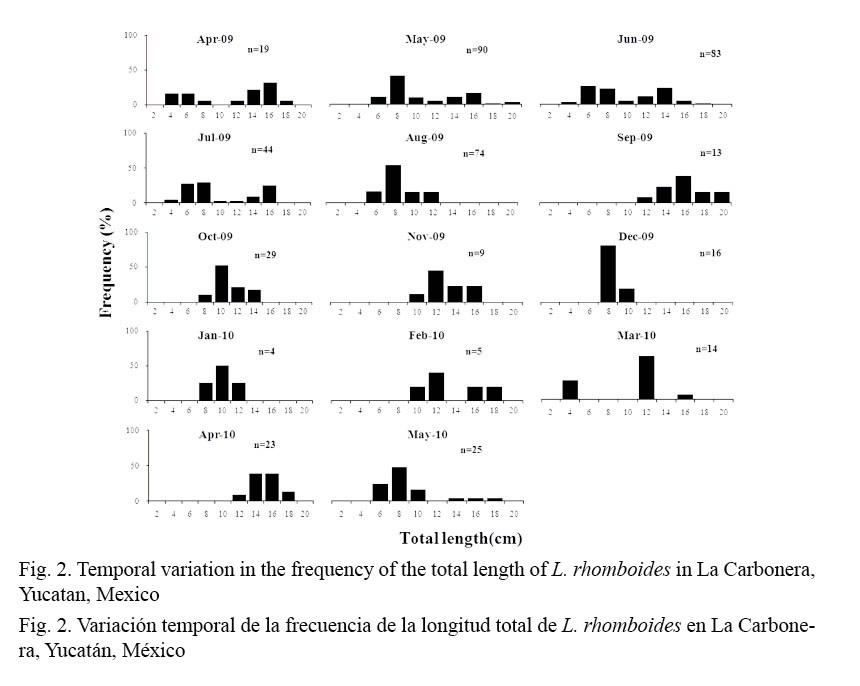
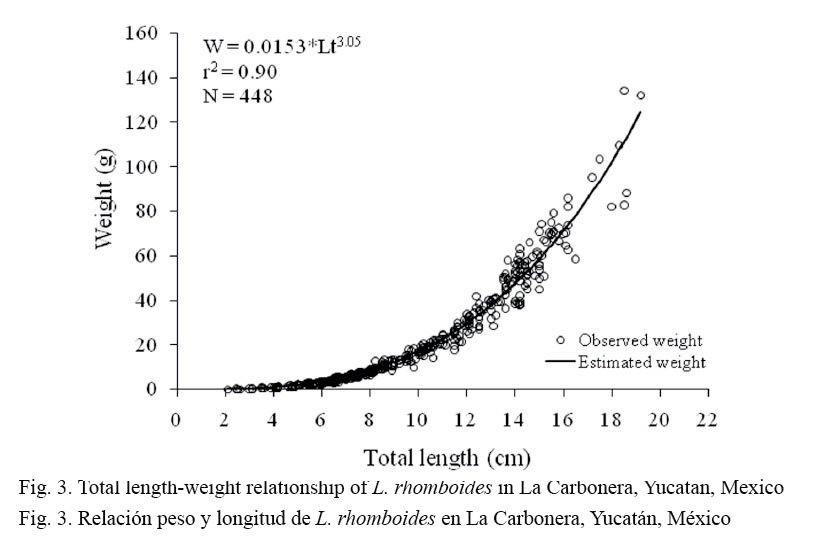
The VBGF parameters calculated were: L∞ = 21.0 cm, W∞ = 163.46, k = 1.1 year-1 and t0 = - 0.158 years. The estimated parameters were obtained using May of 2009 as starting sample and 4 cm as starting length. The estimated maximum length was 22.57 cm (19.91 - 25.24 cm 95% confidence interval). The values of k ranged from 0.63 to 1.2 year-1. The maximum value of the score function (0.540) was estimated at k = 1.1 year-1.
The estimated equations of the VBGF for total length and weight were: Lt = 21.0 [1 - exp- 1.1 (t - 0.158)] and W = 163.46 [1 - exp- 1.1 (t - 0.158)]3.05, respectively.
A new cohort was found during the north winds season (November to February), while the highest frequency of adult sizes was observed in the dry season (March-June) (Fig. 4).
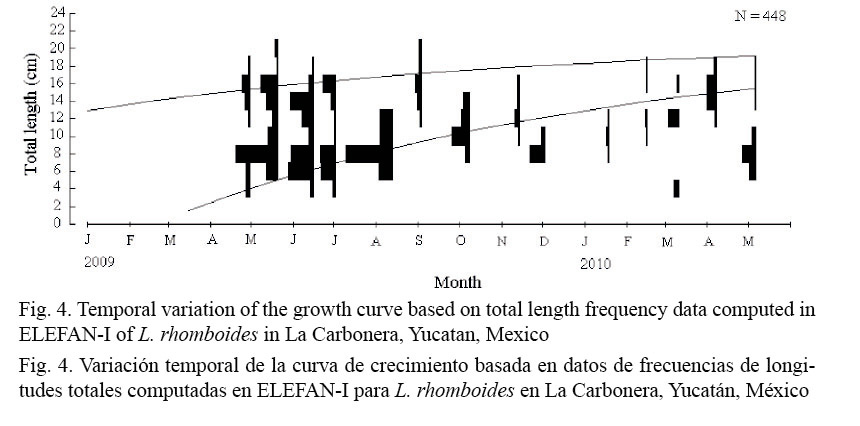
The growth performance index (f') was 2.69, and the maximum longevity (tmax) for L. rhomboides in the study areas was estimated at 2.87 years.
The total instantaneous mortality rate (Z) estimated by the length-converted catch curve was 2.61 year-1 (1.36 - 3.86; 95% confidence interval). Instantaneous natural mortality rate (M) was 2.11 year-1 in relation to the average temperature of the sampling period (28.6 ºC).
Significant differences of the relative condition factor, related to observed and estimated weight, were showed in the monthly values (ANOVA, F = 5.22, P < 0.001), where the highest value was September 2009 and the lowest March 2010 (Fig. 5).
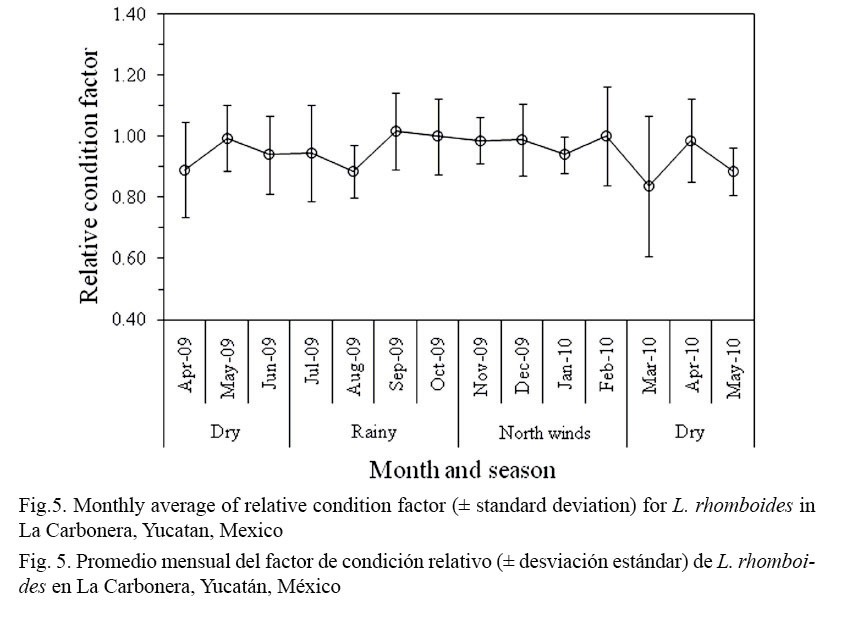
DISCUSSION
L. rhomboides is a euryhaline (Johnson, 1978) and resident species inhabiting the La Carbonera lagoon that has been reported as hypersaline waters (Hellier, 1962; Vega-Cendejas and Hernández de Santillana, 2004). Despite the environmental variability of this region, La Carbonera coastal lagoon provides a favorable habitat and breeding area due to its shallow, sandy bottom and the presence of mangroves (Carpenter, 2002).
Growth parameters for L. rhomboides have not been previously reported for coastal environments around the Yucatan Peninsula, and few studies have been performed to estimate parameters with the von Bertalanffy growth function or length-weight relationship for this species in the Gulf of Mexico (table 1). In the northeastern Gulf of Mexico, VBGF parameters obtained by Nelson (2002) were L∞ = 21.9 cm, k = 0.33year-1 and t0 = - 0.10 years. The growth coefficient k estimated for the northern coast of Yucatan in this investigation (k = 1.1 year-1) is significantly higher than the one estimated by Nelson (2002). According to Nelson (2002), only k showed a latitudinal difference in comparison to this study. Nelson (2002) also reports that, while this species can live up to 7 years (25.5 cm), most fish do not reach this age, whereas the present study found a maximum longevity of 3 years.
In addition, the length-weight relationship exponent remains close to isometric, showing that this species has a proportional volume growth. This isometric growth has been attributed to food availability, low density and productivity characterizing the study area, with productivity being in its highest during the rainy season (Herrera, 1988). However, it is interesting to note that fish up to 5 cm long were recruited in the study area during the dry season, presenting the highest values of temperature and salinity (Fig. 2 and 4).
These results support the view that L. rhomboides could be reproducing at the end of the rainy season, around October. It has been reported that during this season mature individuals migrate to spawn (Muncy, 1984; Darcy, 1985). Additionally, in Tampa Bay, Florida, it has been reported that gonads mature from October to December, which suggests spawning activity occurs during these months (Nelson, 2002).
After spawning, juveniles can reach a total length of 13.7 cm by the age of one year (VBGF of this study), representing half of the time estimated by Nelson (1998) for the Florida population. Juvenile of L. rhomboides of the northern Yucatan coast has a growth rate of 0.6 - 1.4 cm month-1 during the first year, while in Florida the reported growth rate ranges from 0.10 to 0.25 cm month-1 (Nelson, 1998), reaching the reproductive stage at two years when it has grown between 8 and 10 cm in size (Hansen, 1970; Johnson, 1978). The size reached by 50% of the population during maturity was estimated at 13.2 cm (Hansen, 1970). The L. rhomboides population of the northern Yucatan coast could reach the size at first maturity after the first year of life.
The value of the growth index (f' = 2.69) indicates a different growth pattern from the value reported by Nelson (2002). In the growth parameters provided by Nelson (2002) the estimated f' values ranged between 2.17 and 2.21. This could be related to the uncertainty associated with the growth rate (k) estimates obtained by the length frequency analysis, or by variations in the growth rates for populations inhabiting different latitudes with particular environmental and ecological conditions. Pauly (1979) and Sparre et al. (1997) determine that the coefficient of variation of f' should not exceed 4% for growth patterns to be considered statistically similar.
This study presents the first estimates of mortality for L. rhomboides in the Yucatan Peninsula. Nelson (2002) reported a total mortality rate (Z) between 0.88 and 1.08 year-1, these values being lower than those estimated in this study (2.11 - 2.61 year-1). Estimates of total mortality by the length-converted catch curve (Pauly, 1983) are equivalent to the natural mortality rate (Z = M) due to the absence of fishing of this species in the study area (Table 1). The highest M values for the population of the northern Yucatan coast compared to the population of Florida is consistent with the highest growth rate found in Yucatan, taking into account that natural mortality increases in populations with high growth rates.
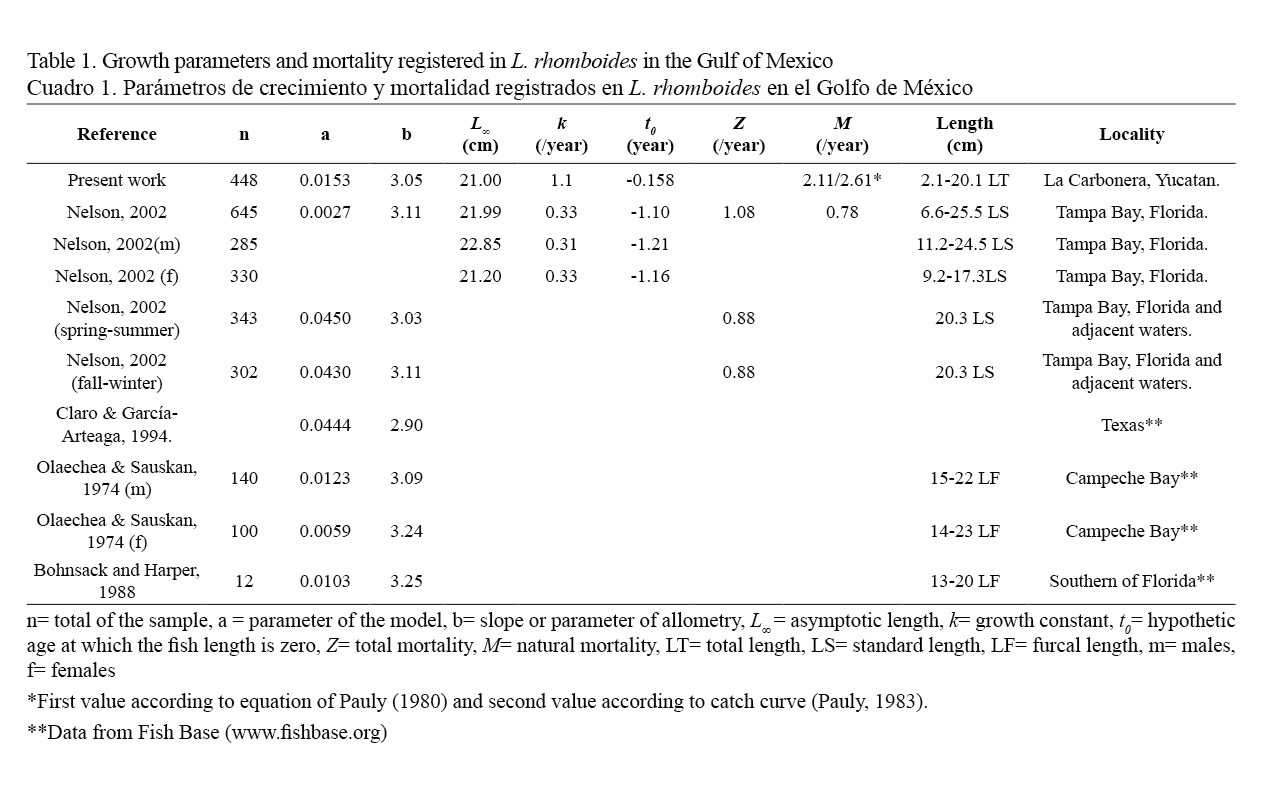
Differences in natural mortality can be attributed to latitudinal dissimilarities according to Bravo et al. (2009), who reported that variations of these parameters could be due to growth differences associated to species present at different latitudes. Based on that research, environmental characteristics such as temperature and photoperiod, which are distinctive in each region, may vary seasonally and are correlated with changes in the abundance and quality of food, harvesting regimes to which they are subjected, and the methodology used to mark differences between the study areas.
The information provided in this study on the basic parameters of the population dynamics of L. rhomboides represents fundamental knowledge of the species to implement the measures and strategies for its conservation on the northern coast of Yucatan.
ACKNOWLEDGEMENTS
This investigation was supported by PAPIIT (IN207609) and FOMIX-Yucatan (103 229) research grants. We thank Alfredo Torres Gallardo, Korynthia López, Carmen Galindo, Joel Loera, and all the members of La Carbonera project team for their technical support during research. We also want to express our gratitude to Chelsea Combest-Friedman and the anonymous reviewers whose comments improved and enriched this manuscript. We are also grateful to CONACyT (Mexico) for the scholarship awarded to pursue doctoral studies in the Postgraduate Program of Marine Sciences and Limnology at the National Autonomous University of Mexico (UNAM).
REFERENCES
Adams, A. J., Locascio, J. V., & Robbins, B. D. (2004). Microhabitat use by a post-settlement stage estuarine fish: evidence from relative abundance and predation among habitats. J. Exp. Mar. Biol Ecol., 299(1), 17-33.
Arceo-Carranza, D. & Vega-Cendejas, M. E. (2009). Spatial and temporal characterization of fish assemblages in a tropical coastal system influenced by freshwater inputs: northwestern Yucatan peninsula. Rev. Biol. Trop. 57(1-2), 89-103.
Beck, M. W., Heck, Jr., K., Able, K. W., Childers, D. L., Eggleston, D. B., Gillanders, B. M., Halpern, B., Hays, C. G., Hoshino, K., Minello, T. J., Orth, R. J., Sheridan P. F., &. Weinstein, M. P. (2001). The identification, conservation, and management of estuarine and marine nurseries for fish and invertebrates. Bioscience, 51(8), 633-641.
Bohnsack, J. A. & Harper, D. E. (1988). Length-weight relationships of selected marine reef fishes from the southeastern United States and the Caribbean. NOAA Tech. Mem. NMFS-SEFC, 215, 1-31.
Bravo, E., Eslava, N., & González, L. (2009). Crecimiento y mortalidad natural del pez Haemulon aerolineatum (Teleostei: Haemulidae) del suroeste de la isla Margarita, Venezuela. Rev. Biol. Trop., 57(3), 699-706.
Canto-Maza, W. G. & Vega-Cendejas, M. E. (2008). Hábitos alimenticios del pez Lagodon rhomboides (Perciformes: Sparidae) en la laguna costera de Chelem, Yucatán, México. Rev. Biol. Trop., 56(4), 1837-1846.
Carpenter, K. E. (2002). The living marine resources of the Western Central Atlantic. Volume 3: Bony fishes part 2 (Opistognathidae to Molidae), sea turtles and marine mammals. FAO species identification guide for fishery purposes and American Society of Ichthyologists and Herpetologists special publication No. 5. Rome, Italy.: FAO.
Claro, R. & García-Arteaga, J. P. (1994). Crecimiento. In R. Claro (Ed.), Ecología de los peces marinos de Cuba (pp. 321-402). La Habana, Cuba.: Instituto de Oceanología, Academia de Ciencias de Cuba.
Darcy, G. H. (1985). Synopsis of biological data on the pinfish, Lagodon rhomboides (Pisces: Sparidae). NOAA Technical Report NMFS 23. Silver Spring, MD, USA.: NOAA/National Marine Fisheries Service.
Gayanilo Jr., F. C., Sparre, P., & Pauly, D. (1997). The FAO-ICLARM Stock Assessment Tools (FiSAT). FAO Computerized Information Series (Fisheries). No. 8. Rome, Italy.: FAO.
Hansen, D. J. (1970). Food, growth, migration, reproduction, and abundance of pinfish, Lagodon rhomboides, and Atlantic croaker, Micropogon undulates, near Pensacola, Florida, 1953-1965. Fish. Bull. 68(1), 35-146.
Hellier, T. R, Jr. (1962). Fish production and biomass studies in relation to photosynthesis in the Laguna Madre of Texas. Publ. Inst. Mar. Sci., 8, 1-22.
Herrera, J. (1988). Productividad primaria ictioplanctónica de1 estero de Celestún, Yucatán, durante el periodo octubre 1983-abril 1984. Unpublished graduate thesis, Universidad Autónoma de Guadalajara, Jalisco.
Hoese, H. D. & Moore, R. H. (1977). Fishes of the Gulf of Mexico: Texas, Louisiana, and adjacent waters. Austin, TX, USA.: Texas A & M University Press.
Johnson, G. D. (1978). Development of fishes in the mid-Atlantic Bight, an atlas of egg, larval, and juvenile stages. Volume 4. Carangidae through Ephippidae. Power plant project. Office of Biological Service. Fish and Wildlife Service. Washington D.C., USA.: U.S. Department of the Interior.
Le Cren, E. D. (1951). The length-weight relation and seasonal cycle in gonad weight and condition in the perch, Perca fluviatilis. J. Anim. Ecol., 20, 201-219.
Martínez-Porchas, M., Martínez-Córdova, L. R., & Ramos-Enríquez, R. (2009). Dinámica del crecimiento de peces y crustáceos. REDVET, 10(10), 1-16.
Muncy, R. J. (1984). Species profiles: Life histories and environmental requirements of coastal fishes and invertebrates (Gulf of Mexico): Pinfish. Mississippi State, MS, USA.: U.S. Army Corps of Engineers Publication.
Munro, J. L. & Pauly, D. (1983). A simple method for comparing growth of fishes and invertebrates. ICLARM Fishbyte, 1(1), 5-6.
Nelson, G. A. (1998). Abundance, growth, and mortality of young-of-the-year pinfish, Lagodon rhomboides, in three estuaries along the gulf coast of Florida. Fish. Bull., 96(2), 315-328.
Nelson, G. A. (2002). Age, growth, mortality, and distribution of pinfish (Lagodon rhomboides) in Tampa Bay and adjacent Gulf of Mexico waters. Fish. Bull., 100, 582-592.
Olaechea, A. & Sauskan, V. I. (1974). Cartas de pesca del Banco de Campeche, 1972, Parte 1. La Habana, Cuba.: Centro de Investigaciones Pesqueras.
Pauly, D. (1979). Theory and management of tropical multispecies stocks: A review with emphasis on the Southeast Asian demersal fisheries. ICLARM Stud. Rev., 1, 1-35.
Pauly, D. (1980). On the interrelationships between natural mortality, growth parameters and mean environmental temperature in 175 fish stocks. J. Cons. CIEM., 39(3), 175-192.
Pauly, D. (1983). Some simple methods for the assessment of tropical fish stocks. Rome, Italy.: FAO. Fish. Tech. Pap.
Robins, C. R., Ray, G. C., & Douglas, J. (1986). A field guide to Atlantic coast fishes. The Peterson field guide series. Boston, USA.: Houghton Mifflin Harcourt.
Shervette, V. R., Ibarra, N., & Gelwick, F. (2007). Influences of salinity on growth and survival of juvenile pinfish Lagodon rhomboides (Linnaeus). Environ. Biol. Fish., 78(2), 125-134.
Sparre, P. & Venema, S. (1995). Introducción a la evaluación de los recursos pesqueros tropicales. FAO Doc. Téc. Pesca 306/1. Rome, Italy.: FAO.
Sparre, P., Ursin, E., & Venema, S. (1997). Introduction to tropical fish stock assessment. Part 1 Manual. Rome, Italy.: FAO. Fish. Tech. Pap.
Vega-Cendejas, M. E. (2004). Ictiofauna de la reserva de la Biosfera Celestun, Yucatán: una contribución al conocimiento de su biodiversidad. Anal. Inst. Biol. UNAM. Zoología, 75(1), 193-206.
Vega-Cendejas, M. E. & Hernández de Santillana, M. (2004). Fish community structure and dynamics in a coastal hypersaline lagoon: Río Lagartos, Yucatan, Mexico. Estuar. Coast. Shelf. Sci., 60(2), 285-299.

Revista Ciencias Marinas y Costeras está bajo una Licencia Creative Commons Atribución-NoComercial-CompartirIgual 4.0 Internacional.
